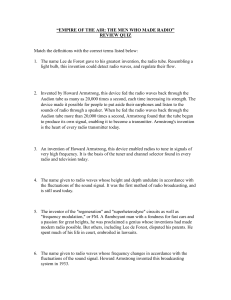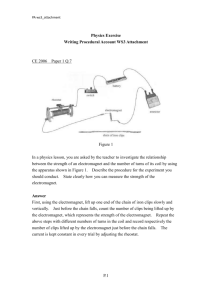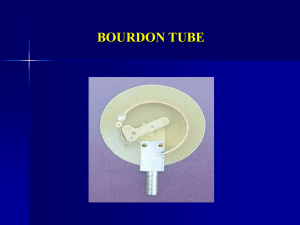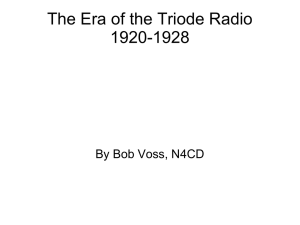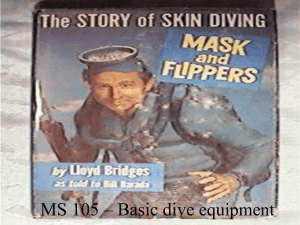History and Development of Radio
advertisement
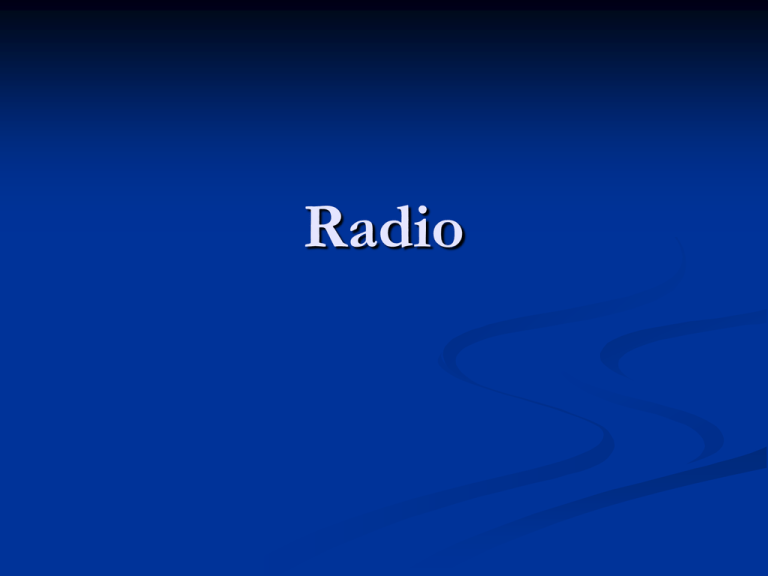
Radio *Warning* Heavy Science Content Ahead Baghdad battery – 250 BCE Electricity was a heavy duty toy for decades, including Ben Franklin and his kite, people rubbing cat skins on glass or amber rods, spinning sulfur balls, and sparking everything and everyone in sight Luigi Galvani - 1786 Believed everything contained electricity Looked for “animal magnetism” Touched different metals to frogs’ legs which twitched Alessandro Volta - 1796 Alessandro Volta - 1796 Volta took Galvani’s experiment and showed that it was the current produced by the different metals that caused the twitch Built a pile of alternating sandwiches of zinc and copper in an acid and created electicity Hans Christian Oersted - 1820 Oersted’s experiment - 1820 In a lecture in Copenhagen he performed an experiment to demonstrate there was no connection between electricity and magnetism by showing that an electric current passing through a wire wouldn’t affect a nearby compass needle Imagine his surprise when the needle swung the moment he turned on the current He demonstrated that electricity created a magnetic field William Sturgeon - 1825 Created the first electromagnet by wrapping wire around a soft iron bar and sending a current through the wire Electricity can create magnetism Michael Faraday - 1826 Reversed Sturgeon’s experiment Showed that magnetism could create an electric current Samuel F. B. Morse - 1838 Used a an on-off switch – the telegraph key – to turn an electric current on and off, sending pulses of current through a wire to an electromagnet that would click in time to the pulses Johannes Mueller - 1840 Examined physical sensations Can you feel colors Can you hear shapes Can you smell sounds Discovered that each sense detects different things We think this is obvious, but no one had proven it before. Remember “common sense”? Herman Hemholtz - 1857 Meuller’s pupil Investigated hearing Noticed sound produced vibrations Did the vibrations operate at different frequencies? They did Thus, sound traveled at different frequencies Used an electromagnet to attract the arms of a tuning fork, causing it to vibrate and produce sound Leon Scott de Martinville phonautograph - 1857 Attached a bristle to a membrane at the end of a cone, set the bristle to touch a piece of smoked glass Spoke into the cone membrane vibrated to the sound and the bristle etched a wavy line onto the smoked glass The Telephone - 1876 Scott’s membrane, Faraday’s electromagnet, Oersted’s and Sturgeon’s electromagnet, Morse’s wire and electrical current, Heimholtz’s vibration, Scott’s membrane Bell and Gray Samuel Morse Heinrich Hertz - 1886 Hemholtz’s pupil Investigated whether electricity traveled in frequencies the way sound did Spark gap generator Hertz’ spark gap experiment Demonstrated that electricity traveled through air at specific frequencies, just like it did through wires Guglielmo Marconi - 1894 Marconi radio Morse key Marconi and his radio Nikola Tesla Tesla coil - 1891 Developed the first amplifier coil, the Tesla coil Raised the voltage of an electrical current high enough to allow the air to conduct the current Key to wireless transmission of radio waves Reginald Fessenden Felt that the variation in electrical amplitude created by a voice, just like on a telephone, could be carried by electrical wave of a radio signal Did the first voice broadcast in 1900 Short range Poor quality Needed far more power Ernst Alexanderson Developed the Alexanderson Alternator, a machine capable of generating the power, up to 100,000 hertz, that Fessenden needed to piggyback voice onto radio waves In Dec. 1906, Fessenden did the first good voice and music broadcast, going hundreds of miles Poetry and a Bible reading A woman singing opera A violin playing a Christmas carol Lee de Forest The audion tube is actually a Fleming valve (British term for tube) invented in England de Forest simply added the bent wire De Forest’s audion tube - 1904 Audion tube amplified the radio signal the way the Alexanderson generator increased the electrical power de Forest didn’t know how the audion worked Another man did Edwin Howard Armstrong Investigated the audion tube, figured out how it worked, and improved it Developed “regeneration” The signal was fed back into the tube over and over again, up to 20,000 times a second Vastly increased the power of the tube to output the signal – it was an amplifier Raise the level enough and the tube becomes a transmitter Armstrong invented the ability to broadcast sound It combined high frequency waves with low frequency waves, then fed them back into the system to amplify the signal and increase its sensitivity Resulted in the creation of the home, and the portable, radio Armstrong’s superheterodyne Armstrong’s next invention was the superheterodyne Crystal Radio David Sarnoff Enamored of radio Saw the possibilities Wrote the “Radio Music Box Memo” that outlined the commercial possibilities of radio RCA (Radio Corporation of America) After World War I Four companies merged their patents to create RCA American Marconi General Electric American Telephone & Telegraph Westinghouse Sarnoff named as commercial manager Used Armstrong’s inventions, building superheterodyne radios to build RCA, the Radio Corporation of America, into one of the biggest companies in the world Radio stations soon opened all over the U.S. Including KWSC (now KWSU) in 1922, one of the first radio stations in the country https://skylight.wsu.edu/ student Examples of programming Operas Concerts Sports News Dramas Comedies Variety shows Soap operas Pretty much everything we get on TV today Fibber McGee and Molly Burns and Allen Fred Allen Abbott and Costello Orson Welles - 1938 Hindenburg disaster - 1937 Edward R. Murrow The Advent of Television It was assumed that radio would be dead Audiences would watch TV instead of listening to the radio TV took over so many of the radio programs Soap operas Dramas Sitcoms Sports news Radio had a great advantage over TV – Portability Take it anywhere Even in the car New kinds of programming Music Top 40 Country Rock Easy listening Golden oldies Talk shows Howard Stern On the Right Rush Limbaugh Michael Savage Glenn Beck On the Left Ed Schultz Stephanie Miller
